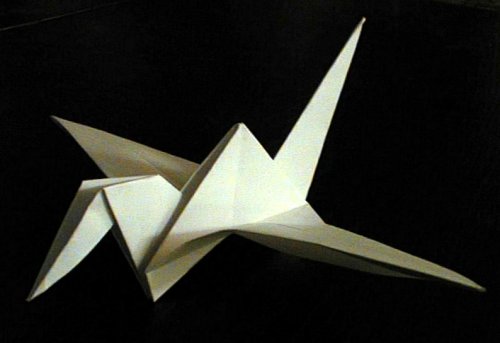Origami
Today, we fold paper. The University of Houston's College of Engineering presents this series about the machines that make our civilization run, and the people whose ingenuity created them.
I linger after my History of Technology class to chat with a student, Michael Adcock. Adcock has just handed in his term paper on a seemingly marginal topic. He's written about origami -- the so-called "Japanese" art of paper-folding. As he explains origami to me, his fingers work on a small square of paper.
I'd never seen myself as an origami folder, but as he talks and as I skim-read his paper, my childhood (dare I say) unfolds before me: the paper boats I sailed each spring in rivulets of melting snow; folded-paper hats; folded gliders that got me into trouble in my grade-school classroom; the paper water-bombs we threw at one another in the hot summer. Today, I still like to fold paper swans with flapping wings.
As we talk, I remember how blank pages of paper lured me. I was dyslexic. Paper was little use to me as material to write upon. But paper, more than any other material, is foldable. Adcock suddenly hands me the figure he's been making. It's a clearly recognizable model of Alfred Hitchcock. He picks up another piece of paper. His fingers move again, and the conversation continues.
The Chinese invented paper in 105 AD. Paper spread to Japan in 538. The Moslems took up paper-making in 704. Paper-folding was soon being done in all three cultures. The Japanese took origami the furthest. Their varieties of folded images became markers of castes. But wherever there was paper, people folded it.
An odd thing goes on today. There's more paper around us than there ever was. But we see far less paper-folding. The two-dimensional computer screen increasingly does our 3-dimensional thinking for us. And origami is rigorously 3-dimensional. It lures people who love to build in the rich space of their own minds.
Jim Yao, of the Texas A&M Civil Engineering Department, saw the trap perfectly clearly. He learned origami as a child in Shanghai. He took it up again in the 1960s. By the 1970s he was using it to lure exactly the kind of students he knew engineering needed. He used folded paper to demonstrate all kinds of structural principles to students, hungry for the chance to see in three dimensions.
In fact, a lot of Euclidean geometry can be done in folded paper. When the English first translated Euclid into English in 1570, the book included many small folded-paper explanations pasted into the text. Origami was part of the story.
In the 1930's, Adcock explains, one great Japanese origamist cataloged 50,000 of his folded shapes. Now origami is on the internet, but there's a catch there. We still don't have workable means for explaining folds on a computer screen. That's still work for the human mind.
"Oh, here," says Adcock as I turn to leave. With a faint smile, he hands me a complex joker's mask -- folded from a single five-inch square of paper.
I'm John Lienhard, at the University of Houston, where we're interested in the way inventive minds work.
(Theme music)
The course mentioned in this episode is MECE 3301, Technology and Western Culture, offered at the University of Houston. The title of Michael Adcock's term paper was "Origami: Art or Science, Discovery or Invention?"
In December, 1998, I found the Corcoran Gallery in Washington, DC, doing an exhibit of large objects made of folded paper. They included a great Christmas tree and an array of large pine cones, as well as other large abstract objects.
For more on origami see the following website, which provides many links: http://web.mit.edu/lavin/www/origami/.
